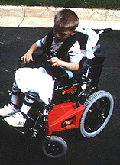Cerebral Palsy
 The words Cerebral Palsy are used to describe a medical condition that affects control of the muscles. Cerebral means anything in the head and palsy refers to anything wrong with control of the muscles or joints in the body. If someone has cerebral palsy it means that because of an injury to their brain (that’s the cerebral part) they are not able to use some of the muscles in their body in the normal way (that’s the palsy part). Children who have cerebral palsy, or CP, may not be able to walk, talk, eat or play in the same ways as most other kids.
The words Cerebral Palsy are used to describe a medical condition that affects control of the muscles. Cerebral means anything in the head and palsy refers to anything wrong with control of the muscles or joints in the body. If someone has cerebral palsy it means that because of an injury to their brain (that’s the cerebral part) they are not able to use some of the muscles in their body in the normal way (that’s the palsy part). Children who have cerebral palsy, or CP, may not be able to walk, talk, eat or play in the same ways as most other kids.
It is important to know that CP is not a disease or illness. It isn’t contagious and it doesn’t get worse, but it is not something you “grow out of.” Children who have CP will have it all their lives.
What Causes Cerebral Palsy?
Cerebral palsy is caused by an injury to the brain before, during, or shortly after birth. In many cases, no one knows for sure what caused the brain injury or what might have been done to prevent the injury.
Sometimes injuries to a baby’s brain happen while the baby is still in the mother’s womb (before birth). The injury might be caused by an infection or by an accident in which the mother is hurt. If a mother has a medical problem such as high blood pressure or diabetes, this can also cause problems in the baby. There may be problems during birth such as the baby not getting enough oxygen, or a difficult delivery in which the baby’s brain is injured. Problems after birth may happen when a baby is born too soon (premature delivery) and his body is not ready to live outside his mother’s womb. Even babies born at the right time can have infections, or bleeding in their brain which causes a brain injury because the brain is still developing even after birth.
The most important thing to remember is that you do not “catch” CP from another person, and you do not develop CP later in life. It is caused by an injury to the brain near the time of birth.
Types of Cerebral Palsy
Children with CP have damage to the area of their brain that controls muscle tone. Depending on where their brain injury is, and how big it is, their muscle tone may be too tight, too loose, or a combination of too tight and loose. Muscle tone is what lets us keep our bodies in a certain position, like sitting with our heads up to look at the teacher in class. Changes in muscle tone let us move.
If muscle tone is too high or too tight, the term spastic is used to describe the type of cerebral palsy. Children with spastic CP have stiff and jerky movements because their muscles are too tight. They often have a hard time moving from one position to another or letting go of something in their hand. This is the most common type of CP. About half of all people with CP have spastic CP.
Low muscle tone and poor coordination of movements is described as ataxic (a-tax-ick) CP. Kids with ataxic CP look very unsteady and shaky. They have a lot of shakiness, like a tremor you might have seen in a very old person, especially when they are trying to do something like write or turn a page or cut with scissors. They also often have very poor balance and may be very unsteady when they walk. Because of the shaky movements and problems coordinating their muscles, kids with ataxic CP may take longer to finish writing or art projects.
The term athetoid is used to describe the type of cerebral palsy when muscle tone is mixed – sometimes too high and sometimes too low. Children with athetoid CP have trouble holding themselves in an upright, steady position for sitting or walking, and often show lots of movements of their face, arms and upper body that they don’t mean to make (random, involuntary movements). These movements are usually big. For some kids with athetoid CP, it takes a lot of work and concentration to get their hand to a certain spot (like to scratch their nose or reach for a cup). Because of their mixed tone and trouble keeping a position, they may not be able to hold onto things (like a toothbrush or fork or pencil). About one-fourth of all people with CP have athetoid CP.
When muscle tone is too low in some muscles and too high in other muscles, the type of cerebral palsy is called mixed. About one-fourth of all people with CP have mixed CP.
